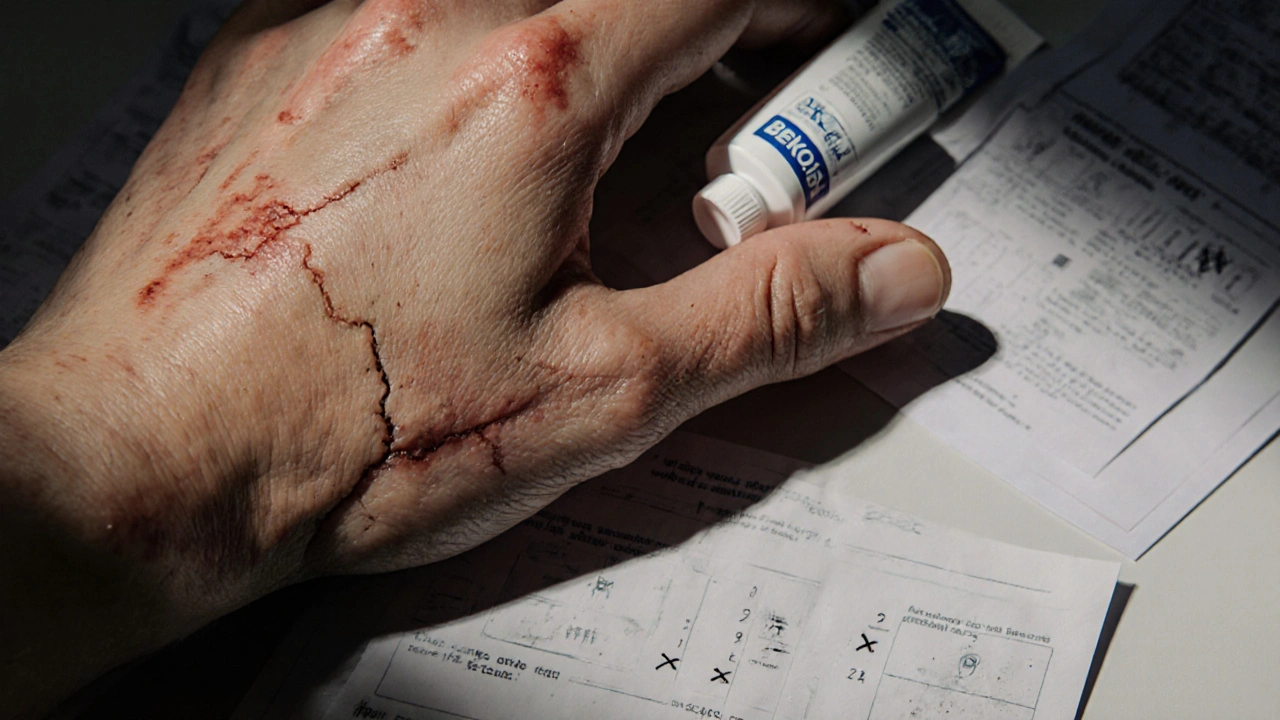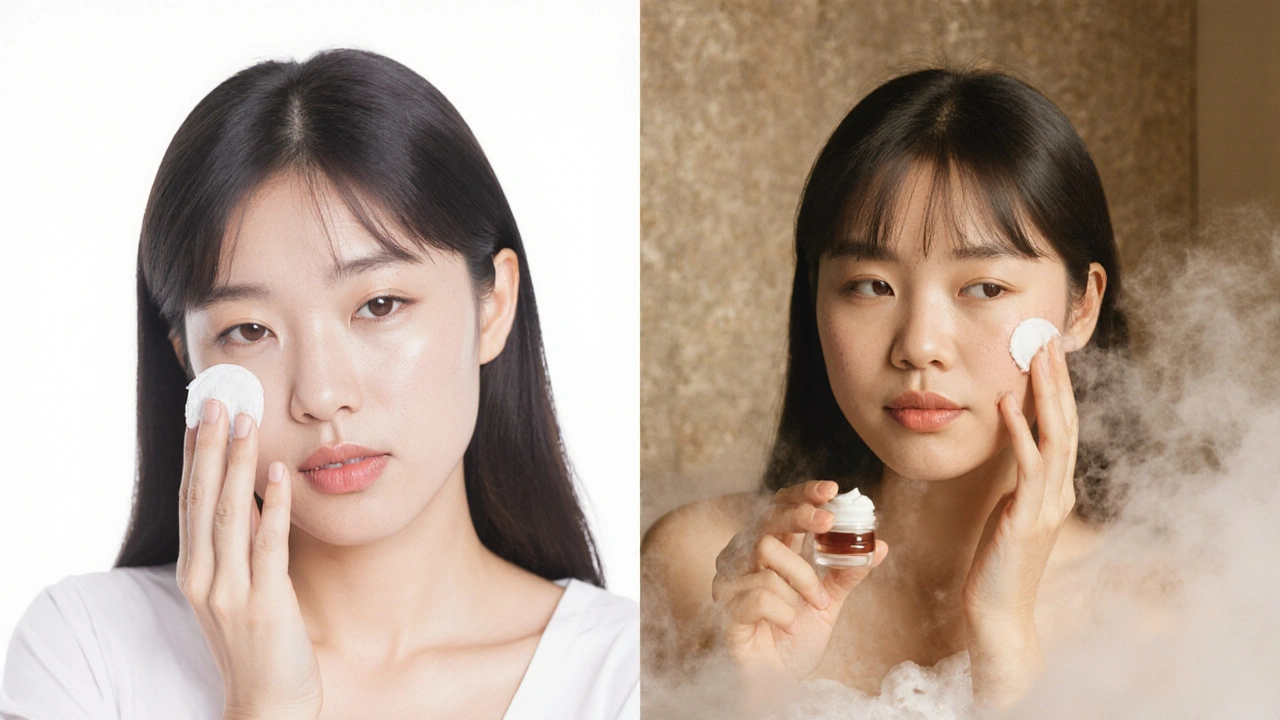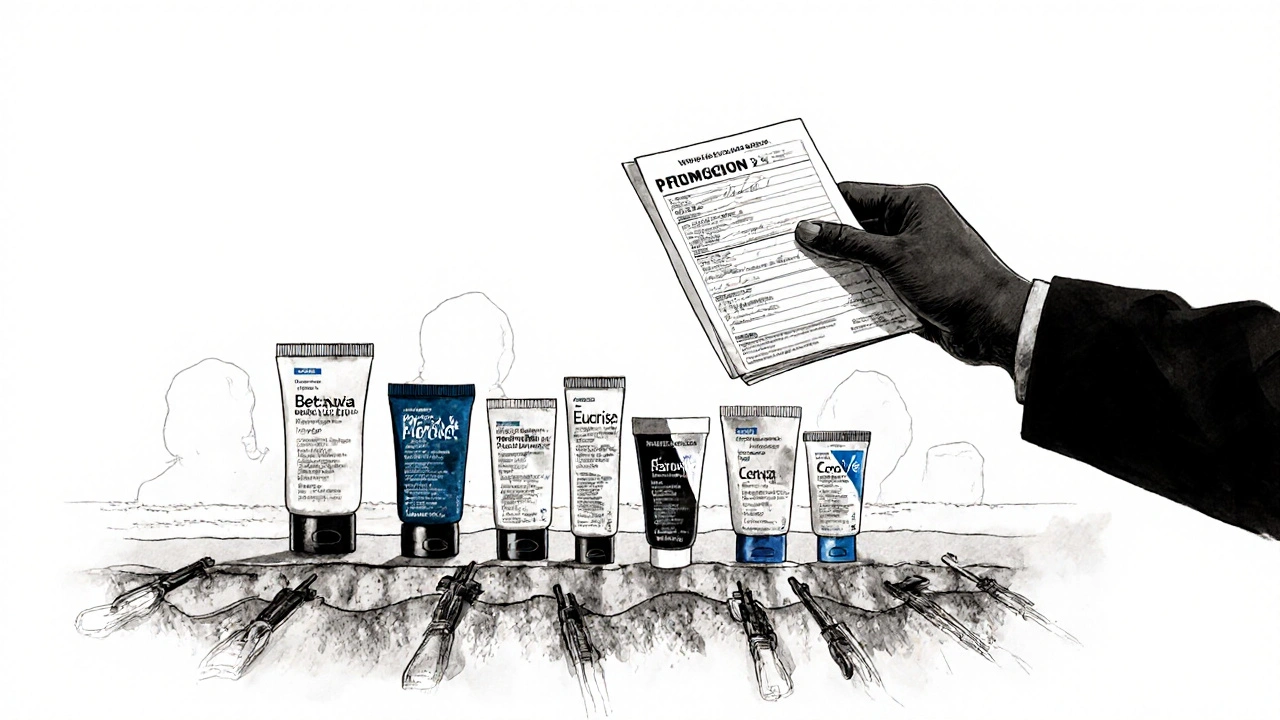Betnovate vs Alternatives: What Works Best for Skin Inflammation?
 Nov, 18 2025
Nov, 18 2025
Steroid Strength Calculator
Find Your Right Topical Steroid
This calculator helps you understand which topical steroid is most appropriate based on your condition severity and location. Remember: stronger isn't always better.
Betnovate is a brand name for betamethasone, a potent corticosteroid used to treat inflammatory skin conditions like eczema, psoriasis, and allergic dermatitis. It works fast - often reducing redness, swelling, and itching within days. But it’s not the only option. Many people wonder: Is Betnovate the best choice? Are there safer, cheaper, or equally effective alternatives? The answer isn’t simple. It depends on your skin type, condition severity, how long you’ve been using it, and whether you’ve had side effects.
What Betnovate Actually Does
Betnovate contains betamethasone valerate, a class II corticosteroid - strong, but not the strongest available. It suppresses the immune response in the skin, calming down inflammation. That’s why it’s so effective for flare-ups. But it doesn’t cure anything. It just hides the symptoms while your body heals. Used correctly, it’s safe. Used too long or too often, it can thin your skin, cause stretch marks, or even make your condition worse when you stop.
Most doctors recommend Betnovate for short-term use - no more than two weeks at a time. If your eczema or psoriasis keeps coming back, you need a different plan, not a stronger steroid. That’s where alternatives come in.
Top Alternatives to Betnovate
There are three main types of alternatives: other topical steroids, non-steroidal creams, and natural or lifestyle-based options. Each has pros and cons.
Other Topical Steroids
Not all steroids are the same. Here’s how Betnovate stacks up against common alternatives:
| Brand/Active Ingredient | Strength Class | Typical Use | Common Side Effects | Cost (NZD, 30g tube) |
|---|---|---|---|---|
| Betnovate (betamethasone valerate) | Class II (Very Potent) | Severe eczema, psoriasis | Skin thinning, acne, burning | $35-$45 |
| Hydrocortisone 1% | Class VII (Mild) | Mild rashes, baby eczema | Rare, usually safe long-term | $10-$15 |
| Clobetasol (Dermovate) | Class I (Super Potent) | Chronic psoriasis, resistant eczema | High risk of thinning, stretch marks | $40-$50 |
| Mometasone (Elocon) | Class II (Very Potent) | Same as Betnovate | Similar to Betnovate | $30-$40 |
| Fluocinonide (Lidex) | Class I (Super Potent) | Thick, scaly plaques | High irritation risk on face | $45-$55 |
Betnovate sits near the top of the potency ladder. If you need something stronger, Dermovate (clobetasol) is available - but it’s overkill for most people and increases side effect risks. If you need something milder, hydrocortisone 1% is safer for daily use, especially on the face or for kids. Mometasone (Elocon) is the closest direct alternative - similar strength, similar price, similar risks.
Non-Steroidal Options
For long-term control, steroids aren’t the answer. That’s where non-steroidal treatments shine.
- Protopic (tacrolimus) and Elidel (pimecrolimus) - These are calcineurin inhibitors. They work by blocking immune signals that cause inflammation, without thinning the skin. They’re approved for moderate eczema and can be used on the face and eyelids. Side effects include burning or stinging at first - which fades after a few days. They’re more expensive than Betnovate ($60-$80) and not covered by all prescriptions, but they’re the go-to for people who can’t use steroids long-term.
- Crisaborole (Eucrisa) - A newer PDE4 inhibitor. It’s a non-steroidal ointment for mild to moderate eczema in adults and children over 2. It’s gentle, doesn’t cause skin thinning, and can be used daily. It costs about $70-$90 for a 60g tube, and isn’t always subsidized. But if you’ve had bad reactions to steroids, it’s a solid option.
- Barrier repair creams - Products like CeraVe, Eucerin, or Aqueous Cream with ceramides. These don’t reduce inflammation directly, but they fix the skin’s natural barrier. When your skin barrier is strong, flare-ups happen less often. Use these daily, even when your skin looks fine. They cost $15-$25 and work best when paired with other treatments.
Natural and Lifestyle Alternatives
Some people turn to coconut oil, oatmeal baths, or aloe vera. There’s limited science, but real-world use shows benefits. A 2023 study in the British Journal of Dermatology found that daily coconut oil application improved mild eczema symptoms as well as mineral oil - and better than no treatment at all. Oatmeal baths (colloidal oatmeal) reduce itching and are safe for kids. These aren’t replacements for strong steroids during flare-ups, but they’re excellent for maintenance.
Also, don’t underestimate triggers. Harsh soaps, hot showers, stress, and even certain fabrics (like wool) can worsen skin conditions. Switching to fragrance-free laundry detergent and using a humidifier in winter can cut flare-ups by half for many people.
When to Choose Betnovate - and When to Avoid It
Betnovate makes sense if:
- Your skin is severely inflamed, cracked, or bleeding
- You’ve tried milder steroids and they didn’t work
- You need quick relief before a big event or during a flare-up
- You’re using it for less than two weeks, under medical supervision
Avoid Betnovate if:
- You’ve used it for more than 4 weeks without improvement
- Your skin is thinning, shiny, or showing stretch marks
- You’re applying it to your face, groin, or armpits regularly
- You’re pregnant or breastfeeding (talk to your doctor - it’s not banned, but caution is needed)
- You’re treating a child under 12 without a specialist’s advice

What Doctors Really Recommend
In New Zealand, dermatologists follow a step-up, step-down approach. Start with the mildest treatment that works. If it fails, step up. Once the flare is under control, step down - often to non-steroidal options or barrier creams.
For example:
- Day 1-7: Use Betnovate twice daily on affected areas (only)
- Day 8-14: Switch to once daily, then every other day
- Day 15+: Stop steroid. Use Eucrisa or Protopic every other day, plus a ceramide cream daily
- Every 3-4 days: Use an oatmeal bath or coconut oil as maintenance
This reduces dependency and side effects. Many patients don’t know they can stop steroids safely - they fear a rebound flare. But with the right plan, most people can taper off without problems.
Cost, Availability, and Prescription Rules
In New Zealand, Betnovate is subsidized under the Pharmaceutical Schedule. With a prescription, it costs about $5-$15 per tube. Unsubsidized, it’s $35-$45. Non-steroidal options like Protopic and Eucrisa are not subsidized - so they cost $60-$90 out-of-pocket. That’s a big barrier for many.
Pharmac doesn’t cover these for mild cases. But if you’ve tried two steroids without success, your doctor can apply for special authority approval. It’s not easy, but it’s possible. Ask your GP or dermatologist - don’t assume it’s off-limits.

What Happens When You Stop Betnovate?
Some people experience “steroid withdrawal” - red, burning skin that flares worse after stopping. This isn’t addiction. It’s your skin’s immune system rebounding after being suppressed. It usually lasts 2-8 weeks. The key is to taper, not quit cold turkey.
Don’t panic if your skin flares after stopping. Use cool compresses, fragrance-free moisturizers, and avoid scratching. If it lasts longer than a month, see a dermatologist. You may need a non-steroidal treatment to bridge the gap.
Final Thoughts: No One-Size-Fits-All
Betnovate is powerful, but it’s not the best for everyone. For short-term flare-ups, it’s hard to beat. For long-term control, it’s a risk. Alternatives like Protopic, Eucrisa, and barrier creams offer safer, sustainable options - even if they cost more.
The real win isn’t finding the strongest cream. It’s building a routine that keeps your skin healthy without relying on steroids. That means combining the right treatment with good habits: moisturizing daily, avoiding triggers, and knowing when to stop.
If your skin keeps coming back, talk to your doctor about a long-term plan - not just another prescription.
Can I use Betnovate on my face?
Only under strict medical supervision. Betnovate is too strong for regular facial use. It can cause skin thinning, acne, or even permanent redness. For facial eczema or rosacea, use milder options like hydrocortisone 1% (for short bursts) or non-steroidal creams like Protopic. Never use Betnovate on your face for more than 5 days without a doctor’s advice.
Is Betnovate better than hydrocortisone?
It depends on severity. Hydrocortisone 1% is safe for mild redness, itching, or baby eczema. Betnovate is 5-10 times stronger and works faster on severe, thickened skin. But hydrocortisone can be used daily for months. Betnovate should never be used daily for longer than two weeks. Don’t swap them without knowing why - stronger isn’t always better.
Are there any natural alternatives that actually work?
Yes - but not as replacements for acute flare-ups. Colloidal oatmeal baths reduce itching and inflammation. Coconut oil improves skin barrier function in mild eczema. Aloe vera can soothe mild burns or irritation. These are best used alongside medical treatments, not instead of them. They’re low-risk and worth trying, especially for maintenance.
How long can I safely use Betnovate?
For adults, no more than 2 weeks at a time. For children, 5-7 days max. If your skin hasn’t improved in 7 days, stop and see a doctor. Long-term use increases risks like skin thinning, stretch marks, and rebound flares. There’s no safe long-term dose - only safe short-term use followed by a transition to non-steroidal options.
Can I use Betnovate with moisturizers?
Yes - and you should. Apply moisturizer first, wait 15 minutes, then apply Betnovate. This helps the steroid absorb better. Don’t mix them in the same jar. Use fragrance-free, ceramide-based moisturizers like CeraVe or Eucerin. Avoid anything with alcohol, perfume, or dyes - they can irritate inflamed skin.
What if Betnovate doesn’t work for me?
It doesn’t mean you’re failing - it means your condition needs a different approach. Some skin conditions like seborrheic dermatitis, fungal infections, or lichen planus don’t respond to steroids. Others need systemic treatment. See a dermatologist for a proper diagnosis. You might need a skin swab, biopsy, or a non-steroidal treatment like crisaborole or phototherapy.